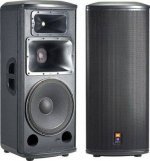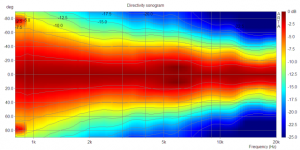Member
Joined 2006
A question on constant directivity...
Drivers:
- SEOS 12+Dayton D250P
- Coral 4" on JBL 10"x15" mid waveguide as in photo
- 10" Altec 406 (in Madera box)
Xover points: minidsp active at 430Hz and 2.6Khz as in JBL.
So from hi to mid it should maintain a ~90 degree constant directivity up to around the 430Hz range..
What about below ~430hz, in this case there should be an abrupt change in directivity in the transition, correct? Audible? Wondering how the directivity profile would be like in the JBL speaker below in that mid to woofer transition...
Drivers:
- SEOS 12+Dayton D250P
- Coral 4" on JBL 10"x15" mid waveguide as in photo
- 10" Altec 406 (in Madera box)
Xover points: minidsp active at 430Hz and 2.6Khz as in JBL.
So from hi to mid it should maintain a ~90 degree constant directivity up to around the 430Hz range..
What about below ~430hz, in this case there should be an abrupt change in directivity in the transition, correct? Audible? Wondering how the directivity profile would be like in the JBL speaker below in that mid to woofer transition...
Attachments
Last edited:
That midrange waveguide is too small to maintain 90 degrees directivity down to 430 Hz. It will be in the range of 150 degrees at that frequency.
Datasheet of a JBL speaker using a similar PT-K95MH waveguide: http://www.jblpro.com/ProductAttachments/AM6200_95.pdf
Datasheet of a JBL speaker using a similar PT-K95MH waveguide: http://www.jblpro.com/ProductAttachments/AM6200_95.pdf
Last edited:
Member
Joined 2006
Thanks for the reply. 
I am guessing... perhaps the mid range directivity carries on with the tweeter at 90 degrees ~2.6Khz to ~150 degrees around 430 Hz gradually, then continues smoothly to the woofer transition?
Would that be the JBL design principle - to have contant directivity at hi then a gradual and smooth increasing directivity from mid to low?
If so, any implication?
I am guessing... perhaps the mid range directivity carries on with the tweeter at 90 degrees ~2.6Khz to ~150 degrees around 430 Hz gradually, then continues smoothly to the woofer transition?
Would that be the JBL design principle - to have contant directivity at hi then a gradual and smooth increasing directivity from mid to low?
If so, any implication?
Last edited:
perhaps the mid range directivity carries on with the tweeter at 90 degrees ~2.6Khz to ~150 degrees around 430 Hz gradually, then continues smoothly to the woofer transition?
Usually cross point is set higher in frequency than where the horn would be covering 150 degrees, and not just for directivity - the horn on axis efficiency usually drops off sharply as the coverage angle increases.
Would that be the JBL design principle - to have contant directivity at hi then a gradual and smooth increasing directivity from mid to low?
If so, any implication?
Yep. There's loads of info in the 'econowave' threads.
http://www.diyaudio.com/forums/mult...dsp-constant-directivity-vs-dipole-study.html
This is a great example, and good as a comparison point (waveguide size vs control), because it is nicely documented, and he's not trying to sell us anything. His speaker gives very constant 90degree coverage, with a blip at 2.5kHz (interestingly, on the JBL pdf that TBTL linked, there's a similar blip).
Note that econowave waveguide size 162mmx303mmx107mm and it is crossed at 1kHz (well above 430Hz).
On the JBL pdf that TBTL linked, the box is 561mm wide, the horn part is about 3/4 of that: about 420mm wide, or ~30% wider than the linked 303mm waveguide. So you'd expect a proportionate reduction in the frequency at which it maintains control.
On the pdf, the JBL horizontal polars plots are in line with this: they begin to converge towards onmi below about 750Hz. So that's where I think you'd want to cross, for similar results to what Gainphile recorded.
EDIT:
Sorry, I missed that you're using a 10" woofer. The econowave chaps usually use a woofer size that's ~equal to waveguide size (width). A 10" won't beam at 90 degrees until about 1600Hz, and crossing that high seems like a waste of a 15" wide waveguide.
Last edited:
Member
Joined 2006
Thanks for the patience..I am a waveguide newbie, just got my first waveguide this month..
Did some more reading.. so for econowave, the idea is to make sure the woofer -waveguide transition is smooth.. as seen in gainfile's own econowave speaker plot below..however, directivity will inevitably decrease with lower freqs from the boxed woofer...
My understanding is what the JBL midrange waveguide does is to provide a smoother 90 to ~150 degree transitions for a dedicated midrange unit, bridging the hi and low freq ones. Of course the ideal would be constant directivity through out...
And I suppose at ~430 Hz around 150 degrees, a 10 in woofer can do the job there similar to a 15 inch in terms of continuity.
Might try to cross out higher than 430Hz to match an open baffle 10 inch....to better fit the narrower directivity..
Thanks very much gentlemen, will report when running these tests..
-------
The JBL PRX535 in the earlier post is comprised of a 15 in woofer, a 6.5 in 195H horn-loaded 90° by 50° mid-range and a 2408H (1.5 in) annular polymer diaphragm, neodymium compression driver mounted to a 90° by 50° horn. Xover frequencies at 430Hz and 2.6khz, respectively.

Did some more reading.. so for econowave, the idea is to make sure the woofer -waveguide transition is smooth.. as seen in gainfile's own econowave speaker plot below..however, directivity will inevitably decrease with lower freqs from the boxed woofer...
My understanding is what the JBL midrange waveguide does is to provide a smoother 90 to ~150 degree transitions for a dedicated midrange unit, bridging the hi and low freq ones. Of course the ideal would be constant directivity through out...
And I suppose at ~430 Hz around 150 degrees, a 10 in woofer can do the job there similar to a 15 inch in terms of continuity.
Might try to cross out higher than 430Hz to match an open baffle 10 inch....to better fit the narrower directivity..
Thanks very much gentlemen, will report when running these tests..
-------
The JBL PRX535 in the earlier post is comprised of a 15 in woofer, a 6.5 in 195H horn-loaded 90° by 50° mid-range and a 2408H (1.5 in) annular polymer diaphragm, neodymium compression driver mounted to a 90° by 50° horn. Xover frequencies at 430Hz and 2.6khz, respectively.
Attachments
- Status
- This old topic is closed. If you want to reopen this topic, contact a moderator using the "Report Post" button.

